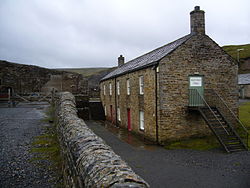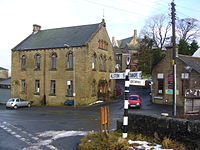Nenthead: Difference between revisions
No edit summary |
m clean up, typos fixed: 80 yard → 80-yard |
||
| Line 16: | Line 16: | ||
==History== | ==History== | ||
Nenthead was not built until the middle of the 18th century and was one of the earliest purpose-built industrial villages in Britain. Nenthead was a major centre for lead and silver mining in the northern [[Pennines]]. The first smelt mill was built at Nenthead in 1737 by George Liddle, and this was subsequently expanded by the London Lead Company. By 1882 the smelt mill was capable of smelting 8,000 bings of ore a year. <ref> p178 Fairbairn (1993) The Mines of Alston Moor.</ref> | Nenthead was not built until the middle of the 18th century and was one of the earliest purpose-built industrial villages in Britain. Nenthead was a major centre for lead and silver mining in the northern [[Pennines]]. The first smelt mill was built at Nenthead in 1737 by George Liddle, and this was subsequently expanded by the London Lead Company. By 1882 the smelt mill was capable of smelting 8,000 bings of ore a year.<ref>p178 Fairbairn (1993) The Mines of Alston Moor.</ref> | ||
Nenthead in 1861 was a bustling village of some 2,000 people, mostly Methodist and employed by the Quaker-owned London Lead Company in the Nenthead Mines - some of the most productive in the country. The benevolent Quakers built, amongst other things, housing, a school, a reading room, public baths and a wash-house for the miners and their families. Nenthead was the first village in the United Kingdom to have electric street lighting from excess power generated by the mines. Life expectancy amongst miners was short, but their children were being educated. | Nenthead in 1861 was a bustling village of some 2,000 people, mostly Methodist and employed by the Quaker-owned London Lead Company in the Nenthead Mines - some of the most productive in the country. The benevolent Quakers built, amongst other things, housing, a school, a reading room, public baths and a wash-house for the miners and their families. Nenthead was the first village in the United Kingdom to have electric street lighting from excess power generated by the mines. Life expectancy amongst miners was short, but their children were being educated. | ||
In the little-known pastime of mine exploring, Nenthead has a special place as many miles of accessible mines remain. It features some of the most stunning mines in the country with several horse whims and an 80 yard engine shaft in [[Rampghill]]. The mines closed in 1961 and there is a Heritage Centre displaying their history. | In the little-known pastime of mine exploring, Nenthead has a special place as many miles of accessible mines remain. It features some of the most stunning mines in the country with several horse whims and an 80-yard engine shaft in [[Rampghill]]. The mines closed in 1961 and there is a Heritage Centre displaying their history. | ||
[[File:Nenthead, Cumbria.JPG|left|thumb|200px|Nenthead old Methodist Chapel]] | [[File:Nenthead, Cumbria.JPG|left|thumb|200px|Nenthead old Methodist Chapel]] | ||
Revision as of 14:07, 27 January 2016
| Nenthead | |
| Cumberland | |
|---|---|
 The mines centre, Nenthead | |
| Location | |
| Grid reference: | NY785435 |
| Location: | 54°47’6"N, 2°20’6"W |
| Data | |
| Post town: | Alston |
| Postcode: | CA9 |
| Dialling code: | 01434 |
| Local Government | |
| Council: | Westmorland & Furness |
| Parliamentary constituency: |
Penrith and The Border |
Nenthead is a small village in Cumberland, and one of the highest villages in the land, at 1,500 feet in the fells. It is found in the very east of the county, at the head of the River Nent. Cumberland's easternmost point, Knowbury Hill, stands close by the village.
History
Nenthead was not built until the middle of the 18th century and was one of the earliest purpose-built industrial villages in Britain. Nenthead was a major centre for lead and silver mining in the northern Pennines. The first smelt mill was built at Nenthead in 1737 by George Liddle, and this was subsequently expanded by the London Lead Company. By 1882 the smelt mill was capable of smelting 8,000 bings of ore a year.[1]
Nenthead in 1861 was a bustling village of some 2,000 people, mostly Methodist and employed by the Quaker-owned London Lead Company in the Nenthead Mines - some of the most productive in the country. The benevolent Quakers built, amongst other things, housing, a school, a reading room, public baths and a wash-house for the miners and their families. Nenthead was the first village in the United Kingdom to have electric street lighting from excess power generated by the mines. Life expectancy amongst miners was short, but their children were being educated.
In the little-known pastime of mine exploring, Nenthead has a special place as many miles of accessible mines remain. It features some of the most stunning mines in the country with several horse whims and an 80-yard engine shaft in Rampghill. The mines closed in 1961 and there is a Heritage Centre displaying their history.

Heritage
The economy of the village is based around tourism and it is the headquarters of a Bus and Coach operator.[2] A popular long-distance cycle route, the 'C2C', passes through Nenthead.
The Grade 2 listed Wesleyan Methodist Chapel has not been used since 2002 but a recent Heritage Lottery Grant of £134,500 has raised hopes of it becoming a café and community hub.[3] The Post Office and Community shop occupies the building which was once a Reading Room for the miners.
Village flag

In 2014, Nenthead adopted a village flag. It sable, two bars argent, on a triangle vert issuant from the hoist two mullets of four points argent, crosswise upon the like saltirewise.
The triangle symbolises the top of the River Nent valley and Knowbury Hill, the easternmost point of Cumberland. The triangle is in the same green as the Cumberland flag. The eight-pointed star of Quakerism recalls the origins of the town and black and white stripes are for the lead (black) and silver (white) which lie beneath the village.
Zinc deposits
In 2013 the Canadian mining company Minco sunk five deep boreholes in an effort to discover the extent of zinc deposits beneath Nenthead. Although test drilling could go on for several years, the company believes that the village may be sited on huge deposits of Zinc; the deposit is 490 feet below the surface and was previously too deep to reach by old mining techniques.[4]
Outside links
| ("Wikimedia Commons" has material about Nenthead) |
References
- ↑ p178 Fairbairn (1993) The Mines of Alston Moor.
- ↑ Wright Brothers
- ↑ Cumberland and Westmoreland Herald 8th March 2014 page 2 'High Sheriff's stamp of approval for Nenthead plan'
- ↑ The Independent (Accessed Jan 12 2014) Gives details of possible zinc deposits.
